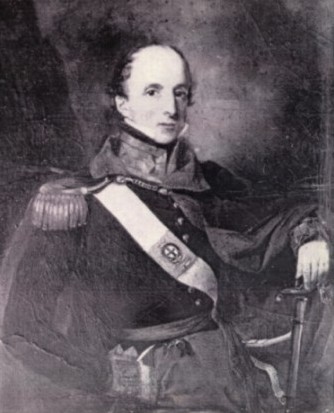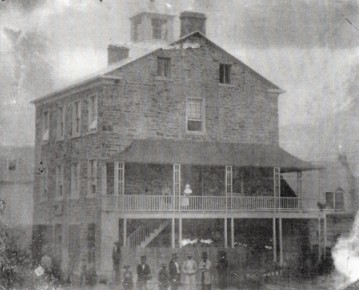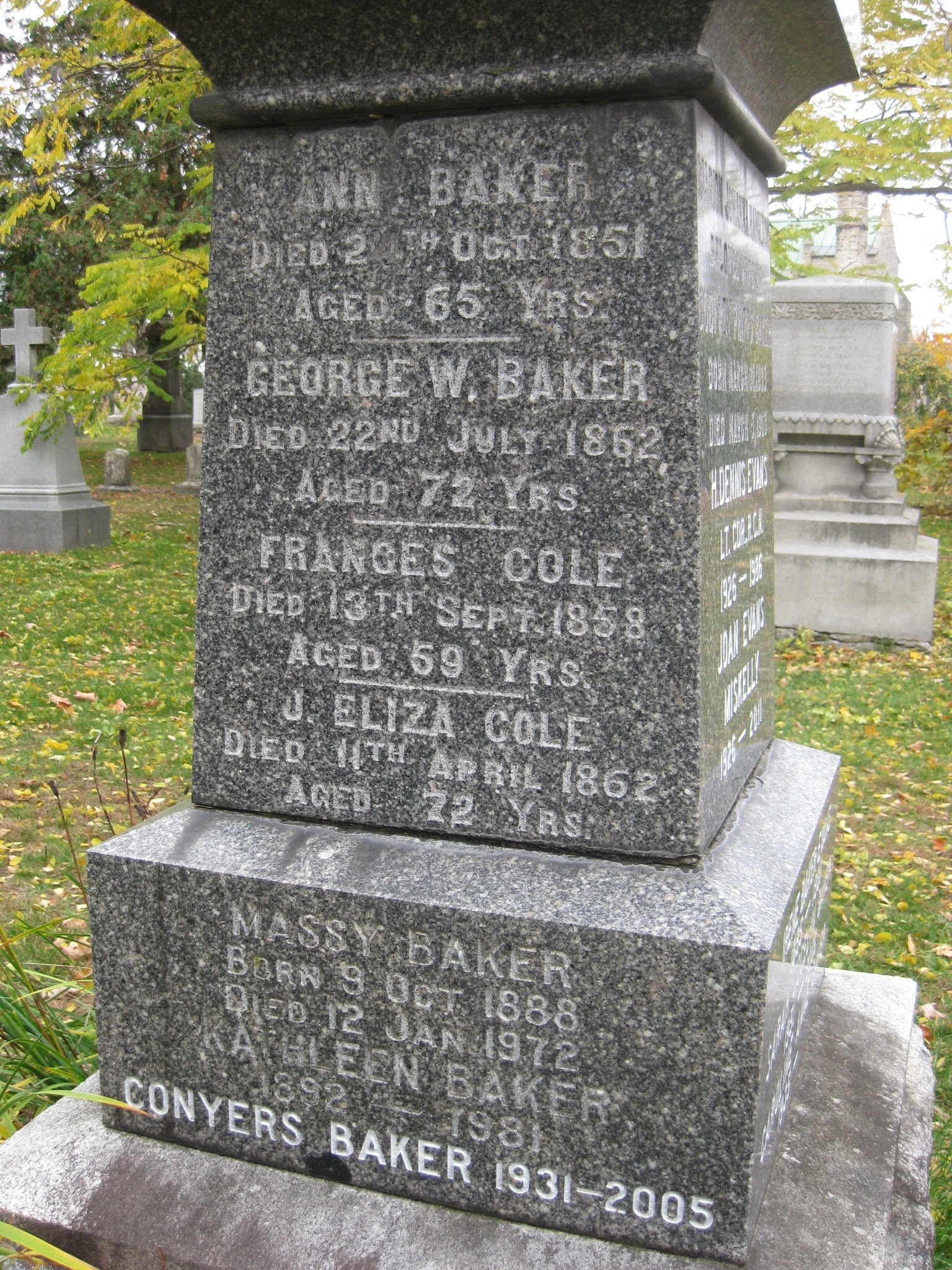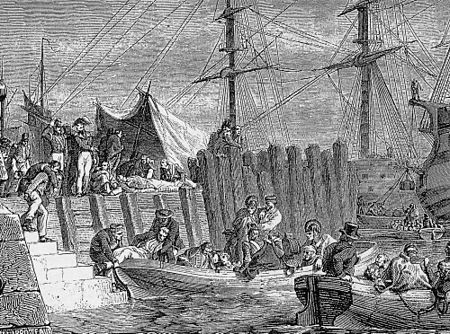
A man of varied attainments, ripe scholarship and vigorous intellect: George William Baker
George William Baker
Section 50, Lot 44
George William Baker was “a man of varied attainments, ripe scholarship and vigorous intellect,” as his 1862 obituary attested. He served the British Empire as an artillery officer fighting Napoleon’s armies and represented the residents of early Bytown as a colonial official trying to preserve law and order in a pioneer lumber town. Great Britain was locked in a global conflict with France, so its military might was focused on defeating Emperor Napoleon Bonaparte throughout Europe and on preventing foreign countries, such as the United States, from trading with its enemy. The Napoleonic wars spawned the War of 1812, as the American republic declared war on Britain on June 18, 1812, and tried to conquer its Canadian colonies. The “American War” was just “an annoying sideshow” for the British imperial command, which concentrated most of its troops, supplies and funds towards crushing the French war machine.
Born in Dublin, Ireland in 1790, Baker joined the British army at nearly 16 years of age as a cadet, rising to full lieutenant and later captain of the Third Battery, Royal Regiment of Artillery. His field artillery company fought in the unsuccessful British expedition to Walchern in the Netherlands, from 1809 to 1810, and the artillery unit was posted to strategic British naval bases at Gibraltar from 1810 to 1812, and at Malta from 1812 to 1814.
The Walcheren Campaign was an unsuccessful British expedition to the Netherlands in 1809 intended to open another front in the Austrian Empire's struggle with France during the War of the Fifth Coalition.
As the War of 1812 entered its third and final year, many of his British compatriots were shipped out to Canada as reinforcements for the regiments struggling to beat off the American invaders. British and American negotiators signed a peace treaty on Dec. 24, 1814.
After the Napoleonic wars ended, Baker’s foreign service continued with a promotion to captain and a posting from 1826 to 1829 to the Trincomalee fortress in Ceylon, now Sri Lanka. Capt. Baker retired from military service in 1832 and emigrated with his family of seven children to Upper Canada.
In 1834, at age 44, Capt. Baker became Bytown postmaster, a post he held until 1857 when he resigned. He was a community leader, serving as reeve of Nepean Township from 1842-1844 and representing Nepean on the Dalhousie District Council from 1842 to 1850, when he was defeated.
He also was a leader in various district agricultural societies during the 1840s and 1850s. He was a shareholder in the Bytown and Prescott Railroad Company and a director of the Mutual Fire Insurance Company of Bathurst District.
The Bytown and Prescott Railway (B&PR) was a railway joining Ottawa (then called Bytown) with Prescott on the Saint Lawrence River. The company was incorporated in 1850, and the first train ran from Prescott into Bytown on Christmas Day, 1854. The 84 km (52 mile) railway, Ottawa's first to outside markets, was initially used to ship lumber collected on the Ottawa River for further shipping along the St. Lawrence to markets in the United States and Montreal.
In 1849, he founded the Bytown Cricket Club whose gentlemen played matches on greens situated on what was then Barrack Hill, later to be the site of Canada’s Parliament Buildings.
In 1840, some thirteen years after the first recorded mention of cricket in Canada , the Carleton Cricket Club was established in Ottawa , then named Bytown. This club was dissolved in 1845 and nothing further was heard of the game until 1849 when the Bytown Cricket Club was established. Among the players at that period were Mr. G.P. Baker, postmaster and often referred to as “the father of Ottawa cricket “, and Mr. F. Clemow, later a Senator. Matches were played with Aylmer , Prescott , Belleville , Kingston and Cornwall . The military in Bytown also provided good opposition. Games in Bytown were played on a site of what is now known as Cartier Square .
Perhaps his most challenging role was as a leading Bytown police magistrate during the Shiners War from 1835 to 1845, when armed Irish gangs of thugs terrorized French Canadian loggers and ordinary citizens.
The Shiners' Wars were violent outbreaks in Bytown (now Ottawa) from 1835 to 1845 between Irish-Catholic immigrants, led by Peter Aylen, and French Canadians, led by Joseph Montferrand. The war began when Aylen, a major Irish timber operator, organized a group of Irishmen to attack other timber operations—this group was known as the "Shiners." The Shiners attacked French-Canadian timber rafts and the town's political institutions, as well as brawling French Canadians on the streets.
In an attempt to control the violence, the citizens of Bytown created the Association of the Preservation of the Public Peace in Bytown, which included armed patrols; however, the violence continued. In the spring of 1837, the violence was brought under control after the government deployed troops to arrest the Shiners.Occasional violence still occurred until 1845 by groups claiming to be the Shiners.
The Bytown magistrates were hard-pressed to control the lawlessness and sectarian violence that sullied the reputation of the town of 3,000. Baker showed civic leadership in trying to break the Shiners’ “power to keep the whole town and neighbourhood in disorder… ”
He pleaded fruitlessly to the British colonial governor for armed soldiers to be stationed in the village, which was still controlled by British military commanders. He wrote that “whole families of unoffending people are obliged to abandon the town and nothing except a military patrol will succeed in arresting the evil and dissipating the general alarm.” When the civilians could not get military aid, they decided to protect themselves. Capt. Baker spearheaded the formation of the Association for the Preservation of the Public Peace, which conducted street patrols drawing on 200 volunteer constables, mostly men from the local militias. Baker also was at the forefront of the civic movement in the late 1840s to establish Bytown as a municipality with its own police force.
The Bytown Association for the Preservation of the Public Peace (formed during the unofficial incorporation of Bytown in 1847), to various municipal police forces, as well as provincial and federal police agencies, the Ottawa area has a rich policing tradition. Policing in Ottawa has continued to evolve to meet the needs of the community. When the town of Bytown incorporated and adopted the name of Ottawa in 1855, Chief Roderick Ross became the first Chief Constable.
With as few as seventeen special constables in the early days reporting to Chief Ross, these police watchmen as they were known, kept law and order in a very rough lumber town. Life as an officer was not easy and their duties consisted of preserving the peace, preventing robberies and other crimes, apprehending offenders, enforce all laws and By Laws, and to collect and provide evidence for the prosecution of offenders. Much of their work involved disturbances related to liquor consumption in a very rough lumber town. Rather than earn a salary, the officers were paid $1 for every culprit they brought in.
He died in 1862, having retired to his farm, Woodroffe, in the township of Nepean.

George William Baker and Ann Cole were originally buried in the Sandy Hill Cemetery in Ottawa, but later transferred to the Beechwood Cemetery on September 12, 1883. A Baker family monument in the Sandy Hill Cemetery was unfortunately not transferred to the new family plot in Beechwood.




